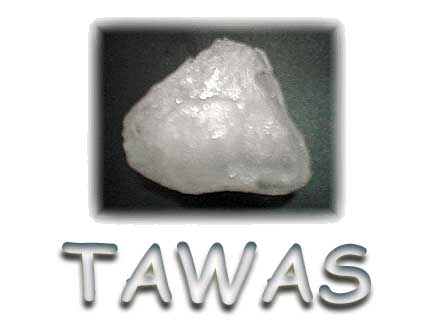|
TAWAS (alum)
has found many applications, both urban and rural. In the urban-suburban
areas, it is used as an axillary deodorant, as local therapy
to herpetic sores and a variety of pruritic or irritated skin
disorders, as a laundry scent, and as a preventive measure for
excessive sweating of the hands and feet.
An indispensible rural
diagnostic tool and treatment modality
In the rural areas, its use is in the purview of the albularyo for a
variety of febrile conditions, a child's incessant crying or failure
to thrive. In these situations, the use is ritualistic. The TAWAS is
used to 'cross' (sign of the cross) the forehead and other suspicious
or ailing parts of the body while prayers are being whispered (bulong).
It is then placed on glowing embers, removed when it starts to crack,
then transferred to a small receptacle of water. As it cools, its softened
form spreads on the water surface and assumes a shape that may suggest
the cause of the illness, often one of several indigenous forces: dwarfs,
devils or other evil spirits (na-nuno, na-kulam, na-demonyo).
The water in the vehicle is then used to anoint the ailing part or parts
of the body to counteract the evil forces or illness. The tawas
is then discarded and thrown westward, preferably into the setting sun.
"Tawas"
as a Diagnostic Ritual
"Tawas"
has evolved from its alum-based use to a diagnostic ritual
utilizing non-alum materials as eggs, pieces of paper, cigarette
rolling paper, fresh-water shells, candles, etc.
The
Egg
A raw egg is cracked into a glass of water and the glass and
the glass gently shaken, the egg white breaking and taking
on unpredictable forms. The egg-white is examined for any
change in shape that might suggest the nature of the illness.
The
Paper
A piece of blank paper, about 4- by 4-inch square, whispered
with prayers (bulong), is "crossed" over the body
of the patient or over the area of affliction then examined
for an shadows or shades for clues to the cause of the malady.
Patients refer to this as "tawas x-ray."
Cigarette
rolling paper
The paper is smudged with
coconut oil; then the healer breathes on it while whispering
his prayers chosen for the procedure. The paper is then brought
up to a light to "read" the shapes that have formed
that will suggest the diagnosis or cause of the malady.
Candles
A lit candle is held close to a mirror and the healer reads
the forms and shapes produced by the heat and smoke on the
mirror surface.
Or, a piece
of candle is heated and melted on a spoon, then placed in
water. The shape taken by the candle on the water will suggest
the nature of the malady to the healer. Not infrequently,
shapes of "dwendeng itim" (black elves) or forms
representing evil spirits are seen, and treatments are so
directed.
|
Diagnosis and treatment
in absentia
Long distance
healing
Some arbularyos use tawas extensively, in diagnosis and treatment, even
in the absence of the ailing patient who might be unable to make the
trip to the healer. In his stead, a piece of recently worn clothing,
usually a shirt or upper garment, is brought to the arbularyo. The healer
crosses the garment with a small piece of tawas, then performs a "bulong"
(whispers a prayer) on the tawas-piece, then places it on the edge of
a small metal dish of fiery embers, intermittently sprinkled with ground
insenso-kamanyang (a combination of chinese incense and tawas). The
dish edge may contain as many as 20 pieces of tawas material, each from
a different patient consulting for diagnosis and treatment. 10 to 15
minutes later, the tawas is lifted out of the smoldering dish and the
arbularyo makes a diagnosis suggested by the shape the tawas has taken
in the process of burning. The diagnosis, sans patient, may run a gamut
of illnesses, from stomach ulcers, stress, infections, spells, goblins
or other mischievoous and evil spirits. Depending on diagnosis, the
arbularyo might prescribed prescription pharmaceuticals or, to counter
spirits and spells, an olio of herbs or indigenous material, rest assured,
empowered by anting-antings or incorporated
with doses of prayers (bulong) and counterspells.
Blue or green tawas
A blue or green variety obtained
from the Mount Banahaw areas, is believed to be specially effective
in countering the effects of "lason" or "dawdaw."
The source of the "poison" is from an egg that has
been buried and allowed to rot for a year. The finger tip nail
is scratched on the egg surface acquiring the "poison",
then surreptitiously dipped in a glass of beverage, water or
alcohol. "Lason" (poison) or "dawdaw" (dipping)
is manifested with acute upper gastrointinal complains of nausea,
vomiting and abdominal pain. The malady may also be induced by
a cigarette that has been "poisoned" on the puffing
end.
Treatment
Green or blue tawas is ground and mixed in half
a glass of drinking water and drank.
SOURCES
Easily available in local market places; a fist-sized rock costing
about P10 ($0.25). Advertised in glossy international catalogues
for $8 to $12.
|





